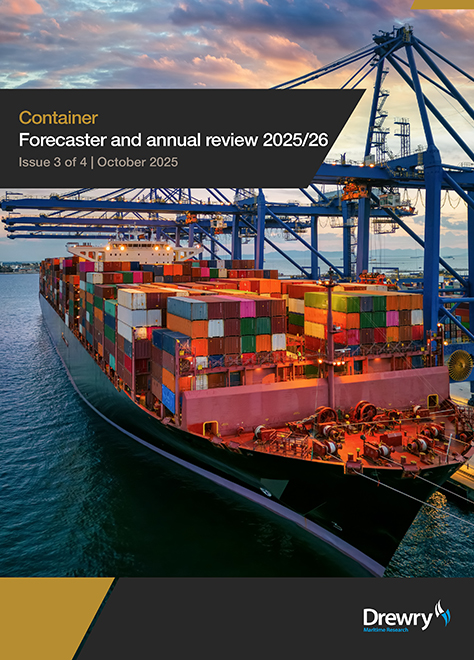News & Events
Overpriced charter market is due a correction after 5-year boom
The container shipping market is witnessing a growing disconnect between the freight rate and charter markets. Drewry expects to see that continue through most of next year, but a correction will follow.
London, UK, 14th October 2025 – Containership charter rates have remained on a steady upwards trajectory this year and remain 200% higher than in 2019, despite slumping spot freight rates (see chart), to which some carriers point as evidence that talk of overcapacity in the market is overblown.
It is not uncommon for the two markets to veer in different directions for a period of time, but the containership charter market has broken records by experiencing a boom for most of the past five years.
Freight rates are much more susceptible to changes in market dynamics, whereas charter rates can often lag freight rates due to multi-month, and even multi-year, fixtures that are set in contractual stone.
These same factors are at play once more, but this time on steroids. Some of the key drivers for this current decoupling between freight and charter rates, in Drewry’s view, are:
1. Tight vessel availability and supply-side rigidity
The core driver of this divergence is vessel scarcity. While demand-side signals (i.e. falling spot freight rates) suggest a cooling market, the supply of available charter tonnage remains constrained. Major liner operators like MSC and CMA CGM have absorbed significant volumes of second-hand tonnage, effectively shrinking the fleet available to non-operating owners (NOOs).
The liner-owned fleet share has increased from 54% in late 2019, to 64% as of early October 2025, a structural shift that reduces market liquidity and gives NOOs greater pricing power. This imbalance has enabled owners to secure long-term charters at premium rates, irrespective of short-term freight volatility.
2. Geopolitical disruption and extended voyage times
Ongoing geopolitical tensions - including Red Sea insecurity - have disrupted traditional trade routes, forcing carriers to reroute ships via the Cape of Good Hope. These extended voyages reduce effective vessel availability and create scheduling unpredictability, which in turn inflates the demand for spot and time-chartered tonnage.
3. Strategic carrier behaviour and forward fixing
Some shipping lines are increasingly focused on service reliability, alliance obligations, and fleet continuity - especially in the face of an uncertain operating environment. This has prompted a shift toward securing long-term charters as a strategic hedge against future disruptions and rate volatility. The result is a surge in forward-fixing activity, with particularly high demand for modern, fuel-efficient vessels.
4. Regulatory pressure and compliance incentives
The introduction and enforcement of emissions-related regulations under IMO and the EU ETS are reshaping fleet preferences. Charterers are now placing a premium on dual-fuel and eco-efficient ships, which are not only regulatory-compliant, but also offer commercial flexibility amid tightening emissions standards. This has added a further constraint on supply, pushing compliant tonnage into a scarcity premium category.
These factors combined mean that NOOs are arguably the most insulated and advantaged players in the current market.
So, when can we expect the two markets to reconnect?
In our view, it won’t happen next year as the same factors will still apply with carriers continuing to charter ships over long durations. Drewry’s Container Forecaster 03 | 2025 edition included average charter rate forecasts for eight different vessel size ranges (up to 8,500 teu) in 2026, with most seeing incremental YoY improvement. In contrast we expect average global freight rates (spot and contract) to decline by around 16%.
Eventually, though, we do anticipate a correction for the charter market, the same way JP Morgan is expecting the stock market to fall after a long boom. With demand growth slowing, carrier profit margins being squeezed, a steady stream of newbuild deliveries and a potential return of Suez Canal transits, at some point the impetus to hire ships will unwind and those long-term charter commitments by carriers will dissipate.
The definitive container market analysis and forecasts
The Container Forecaster is Drewry’s flagship quarterly analysis and outlook for the container shipping market. This long-standing product is highly respected in the market and is widely considered as the go-to reference for what is happening now and what will happen in the future of the global container industry.
Helmed by a team with decades of experience the Container Forecaster provides unparalleled insight, data and forecasts for container trade and regional port volumes. Each quarterly update provides both historical and forecast analysis of the market, including:
- World container trade and regional port volumes forecasts
- Global supply and demand outlook
- Trade route supply and demand analysis
- Global and East-West trade freight rate forecasts
- Carrier profitability analysis
- Charter market and sales & purchases
All quarterly report updates are accompanied by tables, charts and graphs in flexible MS Excel format.
Find out more
© Copyright 2025 | Drewry Shipping Consultants Limited. All Rights Reserved. Website Terms of Use | Privacy Policy




